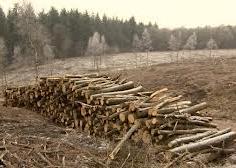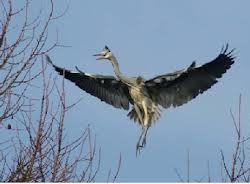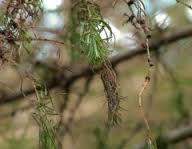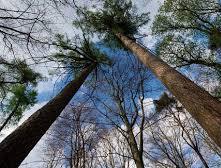 www.bbc.co.uk
www.bbc.co.uk It is natural to wonder what purpose disease plays in God's creation. If each part is important, disease or pathogens must struggle to survive and multiply, just as humans do.
 Heron nests under threat. www.thisissouthwales.co.uk
Heron nests under threat. www.thisissouthwales.co.uk In humans and domesticated plants and animals, substantial efforts have been made to reduce pathogen transmission or to eradicate pathogens from populations altogether. The most commonly adopted strategies include culling (for animals, plants, and disease vectors), behavioral modifications including quarantine and social distancing, and vaccination. Quarantines and social distancing have been applied successfully for human pathogens, including SARS and HIV.
 www.forestry.gov.uk
www.forestry.gov.uk Biologists and economists use the term ecosystem services these days. This refers to the many ways nature supports the human endeavor. Forests filter the water we drink, for example, and birds and bees pollinate crops, both of which have substantial economic as well as biological value.
If we fail to understand and take care of the natural world, it can cause a breakdown of these systems. A critical example is a developing model of infectious disease that shows that most epidemics like AIDS, Ebola, West Nile, SARS, Lyme disease and hundreds more that have occurred over the last several decades don’t just happen. They are a result of things people do to nature. AIDS, for example, crossed into humans from chimpanzees in the 1920s when bush-meat hunters in Africa killed and butchered them.
Disease, it seems, is largely an environmental issue. Sixty percent of emerging infectious diseases that affect humans originate in animals. And more than two-thirds of those from wildlife.
Teams of veterinarians and conservation biologists are in the midst of a global effort with medical doctors and epidemiologists to understand the ecology of disease. It is part of a project called Predict, which is financed by the United States Agency for International Development. Experts are trying to figure out, based on how people alter the landscape (with a new farm or road, for example) where the next diseases are likely to spill over into humans and how to spot them when they do emerge, before they can spread. They are gathering blood, saliva and other samples from high-risk wildlife species to create a library of viruses so that if one does infect humans, it can be more quickly identified. And they are studying ways of managing forests, wildlife and livestock to prevent diseases from leaving the woods and becoming the next pandemic.
It isn’t only a public health issue, but an economic one. The World Bank has estimated that a severe influenza pandemic, for example, could cost the world economy $3 trillion.
Emerging infectious diseases are either new types of pathogens or old ones that have mutated to become novel, as the flu does every year.
 www.itv.com
www.itv.com The worldwide program One Health Initiative, involving more than 600 scientists and other professionals, advances the idea that human, animal and ecological health are inextricably linked and need to be studied and managed holistically.
EcoHealth also scans luggage and packages at airports, looking for imported wildlife likely to be carrying deadly viruses. And they have a program called PetWatch to warn consumers about exotic pets that are pulled out of the forest in disease hot spots and shipped to market.
The knowledge gained by coordinated effort in 20 countries in the last couple of years should allow us to sleep a little easier.
I still don't understand the point of disease. Nor do I understand any type of evil.
Maybe Mother Nature is trying to create a balance between all living things. Mankind's growth is exploding. Soon, no part of the planet will be safe from our population needs. Maybe the trees are fighting back.

 RSS Feed
RSS Feed






